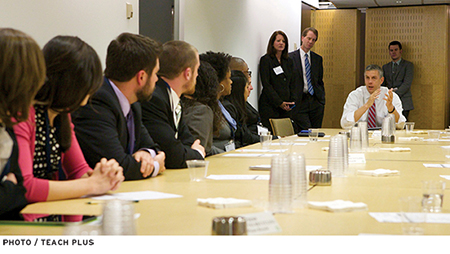 In June 2012, a California judge ruled that the way the Los Angeles Unified School District evaluates its teachers violates state law because it does not factor in student achievement. He ordered the district and the local teachers union to come up with a reasonable way of doing just that. A few days later, Educators 4 Excellence, a group unaffiliated with the local teachers union, released a plan that called for student achievement to count for 40 percent of a teacher’s score. The group then held a dinner, not a formal bargaining session, for teachers to discuss the issue directly with Los Angeles superintendent John Deasy. Writing on Twitter, Deasy described it as “one of the most thoughtful models that has been worked out.”
In June 2012, a California judge ruled that the way the Los Angeles Unified School District evaluates its teachers violates state law because it does not factor in student achievement. He ordered the district and the local teachers union to come up with a reasonable way of doing just that. A few days later, Educators 4 Excellence, a group unaffiliated with the local teachers union, released a plan that called for student achievement to count for 40 percent of a teacher’s score. The group then held a dinner, not a formal bargaining session, for teachers to discuss the issue directly with Los Angeles superintendent John Deasy. Writing on Twitter, Deasy described it as “one of the most thoughtful models that has been worked out.”
Around the same time, Boston teachers packed into their union hall to vote on a procedural change that would allow them to cast ballots by mail in biennial elections of officers. At the time, the Boston Teachers Union required its members to show up in person on a school day to vote at the South Boston union hall, which had the effect of ensuring a low turnout. Only 13 percent of the union’s members, including retirees, had voted in the previous election. The proposal to change that practice fell five votes short of the two-thirds majority it needed to pass. “Teachers’ voices matter,” a Boston teacher who supported the change wrote on his blog. “We can, and must, do better in our own union to make our professional organization accessible to, and responsive to, ALL of us.”
That same month, Orchard Gardens, a historically low-performing K–8 school in Roxbury, Massachusetts, wrapped up its second year operating with a Teacher Turnaround Team. The team is made up of top teachers recruited with a promise that they could lead the school’s improvement effort while earning a $6,000-per-year stipend. “As long as we get the ends, we have a lot of flexibility to decide on the means,” said Lynni Nordheim, 30, a 4th-grade teacher who came to the school after teaching six years in Las Vegas. T3, as the turnaround strategy is known, was developed by teachers Boston-based Teach Plus selected for its first 18-month education-policy fellowship in 2007. Teach Plus continues to recruit, develop, and support teacher leaders through partnerships with 13 schools in three districts, including Boston (see sidebar).
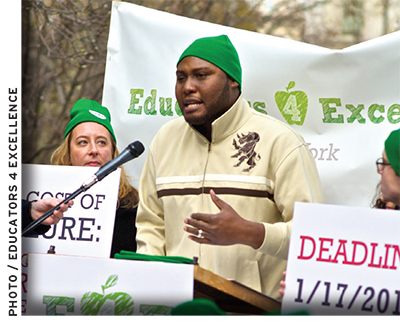
Each of these anecdotes represents a facet of a small but rapidly growing national movement to give classroom teachers opportunities to make a mark on their profession and on public education. Several new groups work to amplify the voices of top classroom teachers as they weigh in on controversial policy issues, as with the evaluations in Los Angeles. The Hope Street Group National Teacher Fellows, the New Millennium Initiative, and the Viva Project, a digital platform for crowdsourcing teachers’ ideas, all fall into this category.
The aim of another set of programs is to keep successful teachers in the profession by giving them opportunities to assume leadership roles, as with Teach Plus and its T3 project. A fellowship program launched in 2008 by Leading Educators, which began in New Orleans and is now operating in Kansas City and will soon expand into Detroit and the District of Columbia, for example, provides a select group of teachers with training in education issues, management, leadership, and problem solving.
A third front in the so-called “teacher voice” movement pushes local unions to become more democratic. The move in Boston to change the voting rules began with a small group of union members, and in less than a month more than 1,200 teachers had signed a petition in support of the change. The issue was brought up for another vote last September, and it passed. Another such effort, NewTLA in Los Angeles, operates as a caucus within the union there.
Regardless of the approach, all of the groups unabashedly acknowledge that some teachers are more effective than others and that even the best teachers want to keep improving their practice. Rather than seeing themselves as adversaries to either unions or school districts, teachers who get involved in these groups tend to think of themselves as problem solvers. As a result, many district, state, and national education policymakers view them as more authentic classroom voices than union activists.
Union Limits
“We as teachers have this wealth of knowledge and expertise that oftentimes goes unrecognized in our profession,” said Geneviève DeBose, a 5th-grade teacher at the Bronx Charter School for the Arts. Last year, DeBose took a leave from her classroom to serve as a Teacher Ambassador fellow in the U.S. Department of Education, which is also working to amplify the voices of teachers. She and 15 others chosen for the honor organized more than 200 roundtable discussions attended by more than 3,000 teachers across the country, seeking their views on an Obama administration proposal to change how teachers are recruited, prepared, licensed, supported, promoted, and compensated. The conversations gave “teachers the opportunity to put their stamp on something before it becomes policy, which is usually not the case,” DeBose said. Last September, DeBose, a board-certified teacher, decided to continue her national leadership work by joining the National Board for Professional Teaching Standards as director of Educator Engagement.
In his 1975 book Schoolteacher, sociologist Dan Lortie explained that teachers have had little say over policy because, as a group, they do not believe they possess specialized technical knowledge out of the reach of nonexperts. Instead, they tend to think of what they do as a matter of personal style and preference. That makes teachers “less ready to assert their authority on educational matters and less able to respond to demands from society,” he wrote. Given teachers’ lack of confidence in their expertise outside the classroom, many legislators, school boards, and administrators “do not believe they require teacher participation” in important decisions.
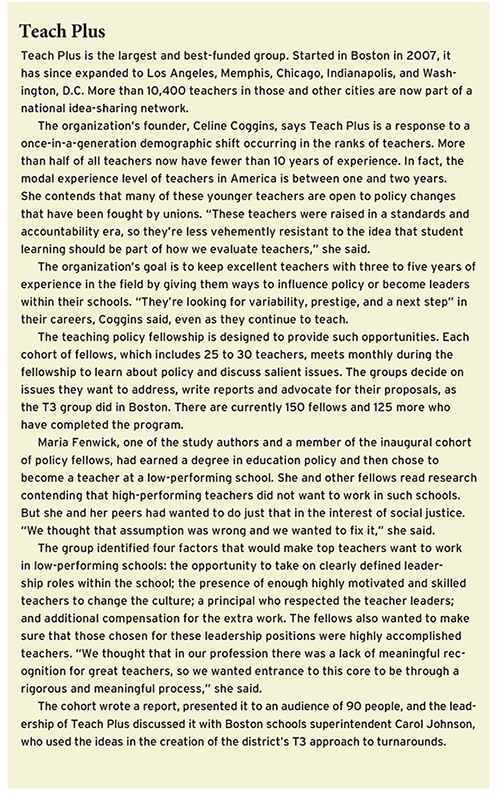 The unions representing teachers emerged in the 1960s to make sure the interests of teachers were protected in those decisions, using such tactics as collective bargaining, legislative lobbying, and support of candidates friendly to their cause. Modeling themselves on industrial unions, they fought successfully for better and more equitable salaries, job security, and improved working conditions, such as limits on class size.
The unions representing teachers emerged in the 1960s to make sure the interests of teachers were protected in those decisions, using such tactics as collective bargaining, legislative lobbying, and support of candidates friendly to their cause. Modeling themselves on industrial unions, they fought successfully for better and more equitable salaries, job security, and improved working conditions, such as limits on class size.
The unions did not, however, seek to gain influence over teaching itself. In part, that was because of the individualistic perspective on what it means to be a good teacher noted by Lortie. A bigger reason was that union leaders (an exception was, in his later years, Albert Shanker of the American Federation of Teachers) believed that supervision and quality control was a management responsibility. The union’s role was to enforce fairness, through rigid salary schedules, a fetish-like attachment to seniority policies, and aggressive enforcement of due process rules.
That has left unions ill-prepared to respond to current demands on teachers and schools to boost test scores, increase graduation rates, and better prepare students for success in college or on the job. They’ve been unable to block the rapid spread of policies that seek to link tenure decisions, the order of layoffs, job security, and even compensation to performance. And, in a dozen states, including Wisconsin, Ohio, and Idaho, the unions have found themselves fighting just to maintain collective bargaining rights. Meanwhile, union membership is falling.
Both Randi Weingarten, president of the American Federation of Teachers (AFT), and Dennis Van Roekel, president of the larger National Education Association (NEA), recognize the threat. In his keynote speech to NEA’s Representative Assembly in July 2012, Van Roekel said teaching is “OUR work…OUR profession.” But, he said, “that sure doesn’t stop everyone from having an opinion on how to do our work, does it?” Van Roekel said that “teachers are willing to take responsibility for student success—and they want and deserve a voice in how they’re trained, supported, and evaluated.”
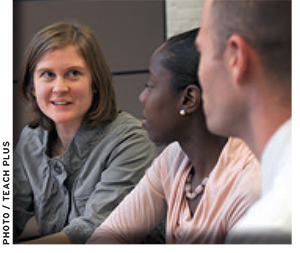
In 2010, Van Roekel appointed a commission to make recommendations on the role the NEA should play in improving teacher effectiveness. Led by Maddie Fennell, Nebraska’s 2007 State Teacher of the Year, the commission issued a report in 2011 that sketched out a vision of the profession in which teachers have a say in decisions about hiring, evaluating, promoting, and dismissing their fellow teachers. Fennell said the union “has to grapple with the fact that not all teachers are equally effective and some are not cut out to be teachers.” But, she said, even that obvious truth is controversial among union stalwarts. According to Fennell, the recommendations were embraced by NEA leadership but have met resistance from middle managers within the union.
Since then, Fennell has worked to increase the influence over education policies of the National Network of State Teachers of the Year, whose membership comprises current and former honorees.
A national survey conducted in the fall of 2011 for the Washington-based think tank Education Sector found that more than 40 percent of teachers want their unions to focus more on teacher performance and student achievement than they currently do. The same survey found that less than half of teachers consider unions to be absolutely essential. Another survey, conducted by Harvard’s Program on Education Policy and Governance on behalf of Education Next, found that only 43 percent of teachers have a positive view of unions, while the percentage of teachers holding negative views doubled from 2011 to 2012 to 32 percent (see complete results for 2011 and 2012 Education Next-PEPG surveys at www.educationnext.org). Of course, the latter survey doesn’t indicate whether teachers are ambivalent because the unions aren’t fighting hard enough against policy changes affecting job security or because they’re fighting too hard to defend poor performers.
Educators for Excellence
Among those who think that unions need to better represent the diverse views of their members are Evan Stone and Sydney Morris, former Teach For America corps members who worked for several years at the 2,000-student P.S. 86 in the Bronx, New York’s largest elementary school. They were in their third year on the job when they began to get frustrated. “We realized there was this weird juxtaposition,” Stone said. “Inside our classrooms we had so much autonomy and control, and outside we had no control or influence in the school, the district, or beyond.”
Initially, the pair thought that the United Federation of Teachers (UFT), in New York City, would provide them with the platform they needed to make their views known to district leaders. But they were disappointed. “We went to meetings and realized that much of the dialogue was one way,” said the 27-year-old Stone, a Yale graduate. “We were being told what to do, or what to think, rather than being asked what we thought.”
In March 2010, at a meeting of like-minded teachers in a coffee shop on Avenue B in the East Village, they decided upon a particularly American course of action: they would form an advocacy group with the audacious aim of transforming the profession that many of them had so recently joined. Soon after, the group, known as E4E (Educators 4 Excellence), issued a statement of “principles and beliefs,” most of which just happened to run counter to union orthodoxies. Teachers who want to join are expected to pledge to support using value-added test-score data in evaluations, higher hurdles to achieving tenure, the elimination of seniority-driven layoffs, school choice, and merit pay.
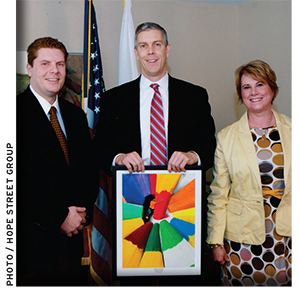
Stone said the manifesto is “somewhat of a line in the sand” but also an organizing tool to “bring together solutions-oriented teachers around a common set of beliefs” about issues relevant to their profession.
Since then, nearly 8,000 teachers have signed the manifesto; E4E has chapters in New York City, Los Angeles, and Minnesota; and Stone and Morris have left their teaching jobs to work full-time to expand the group nationally. In an e-mail, Morris, 27, a Tulane graduate, explained the group’s appeal by saying teachers “are tired of being treated as subjects of change, instead of as partners in transforming the education system.” She said E4E gives teachers an outlet for those impulses through its online and in-person community of like-minded teachers, events at which education officials such as New York state education commissioner John King hear from them directly and seek their advice, and opportunities to participate on committees that write specific policy recommendations.
In New York, recommendations by a group of E4E teachers on how appeals of low performance ratings should be handled were incorporated in the teacher-evaluation policy Governor Andrew Cuomo announced last year. Before that, a group of 11 teachers affiliated with E4E developed a proposal for an alternative to seniority in determining who would be let go in the event of layoffs. The group recommended that teachers who were frequently absent, those who had been judged unsatisfactory by their principals, and those who did not have a permanent job assignment should be the first to go.
Those ideas were welcomed by New York City mayor Michael Bloomberg at a time when he was very much at odds with the UFT. Critics responded with scorn and hostility, calling E4E members “anti-union scum” and “union-busting plants” in online forums. One comment on a GothamSchools blog post complained that “in the past all young teachers paid their dues, and didn’t complain about being low man on the totem pole” in the union. Morris said E4E is not anti-union. “We’re trying to strengthen the union in the long run by having it become more representative of its members,” Morris said.
Susan Keyock is “school captain” for E4E at Metropolitan High School in the South Bronx. She became a special education teacher in Denver after several noneducation jobs and became involved there explaining to her peers the benefits of the performance pay program called ProComp. She wanted to push for similar ideas in New York but did not find the UFT to be receptive. Her affiliation with E4E has given her a chance to engage her fellow teachers in discussions about policies. “Teachers want a fair and transparent evaluation system so we can all become better teachers,” she remarked. She said teachers new to the field “want the union to be student-focused, achievement-focused, and data-focused and want their union to be perceived positively by the public.”
Grass Roots or Astroturf?
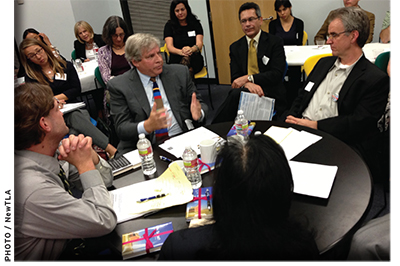
Leo Casey, a UFT vice president, said he doubted that E4E has as many supporters among New York teachers as it claims. Most teachers, he said, are opposed to being judged based on student test scores and believe that the current seniority system is fair and necessary. He said that E4E is seen by many in the union as too close to Bloomberg. “The issue of being hand in glove with the mayor’s campaign on seniority raises real questions about the group’s independence,” Casey said. “The perceptions of them are pretty strongly fixed at this point.” In January, the UFT and the school district ended negotiations over a new evaluation system in the city, which could lead to the loss of $450 million in state and federal aid.
Some opponents of unions have indeed applauded the emergence of alternatives. But Brad Jupp, a former teachers union leader who is an advisor to U.S. Secretary of Education Arne Duncan, said, “We have to resist turning these teacher voice groups into foils for the union or seeing them as flanking operations.
“What they want is personal efficacy, and they look at unions and districts alike as organizations that do not nurture personal efficacy,” he said. “Policy influence can give them that.”
AFT president Weingarten said E4E “tends to be a wedge against the union” and that “people are really skeptical about groups formed with other people’s money.”
These groups do face the challenge of proving that they represent the grassroots views of teachers and are not part of a foundation-funded “Astroturf” campaign to discredit unions. The groups do not charge dues and so are completely dependent on grants. Funders include the Ford Foundation, the Chicago-based Joyce Foundation, the Stuart Foundation in California, the Laura and John Arnold Foundation of Houston, the Hewlett Foundation, and Bloomberg Philanthropies, the foundation created by New York’s mayor. The largest source of funding is the Bill & Melinda Gates Foundation, which currently has $13.5 million invested in nine teacher-advocacy groups, including $975,000 over two years going to E4E. But the foundation has also given $4 million to the AFT and $500,000 to the NEA to fund similar projects.
Gates is a major supporter of the Hope Street Group, a national think tank and consulting firm that formulated the language for the Obama administration’s Race to the Top grant program, which is opposed by many teachers and union leaders. Founded in Los Angeles in 2003 by “pro-market” business executives and professionals who believed in the power of incentives to affect behavior, the group’s consultants are now helping five states develop teacher-evaluation systems. The group believes teachers should earn higher salaries and be “rewarded for what matters most: good classroom outcomes.” The Hope Street Group’s teaching fellows program was created to help spread that message. Seventy teachers applied for 50 slots for this school year. Those chosen received a $5,000 stipend and, in return, are expected to help states implement the new teacher evaluations, using a “playbook” created by Hope Street.
Another nonprofit organization that offers fellowships is America Achieves, founded in September 2010 in New York City by a group that includes Jon Schnur, who has been an advisor to President Obama and Secretary of Education Arne Duncan. The organization’s goal is to give educators greater influence over policies, promote “evidence-based” reforms, and raise student achievement, principally through the Common Core State Standards. Fellows are chosen based on their track record for improving student achievement, and are given opportunities to advise local, state, and national policymakers at convenings, as well as informally. As of spring 2012, 50 educators, including eight principals, were participating.
The New Millennium Initiative (NMI), another “teacher voice” fellowship, was launched in 2009 by the North Carolina–based Center for Teaching Quality. Teachers selected for the fellowship want to be the “chief agents of change” in their local communities, according to the organization. Jessica Keigan is a fellow based in Denver, one of five locales with an active NMI group. A high-school English teacher in her ninth year, Keigan and other fellows have been involved in shaping the details of SB 191, the Colorado reform bill that made major changes to teacher-related policies, including evaluations and tenure.
Keigan said the Colorado Department of Education invited the NMI fellows to participate in the process after they wrote a paper about it. “While most of us have concerns … we’re trying to make sure the implementation is the best it can be,” she said.
All of these groups make heavy use of social media for connecting participants and sharing their views. None more so than the Viva Project, which stands for Vision, Idea, Voice, Action, and was started by a Chicago-based community organizer and policy activist involved in promoting the spread of charter schools in the state. The organization’s motto is “classroom teachers should be the defining voice in education policy.” The project creates virtual “idea exchanges” and invites teachers in a given district or state to contribute video or written commentaries. Those who are most active are asked to join a “Writing Collaborative.” The collaboratives produce reports, which are put in the hands of policymakers. Viva teachers have influenced policies related to extending teaching time in Chicago, principal evaluations in Minnesota, teacher evaluations in New York, the implementation of Common Core standards in Arizona charter schools, and the U.S. Department of Education’s efforts to increase teacher professionalism.
A New Unionism?
Randi Weingarten said she is open to working with groups that don’t share the union’s point of view and that Teach Plus has been an ally in some instances. But, she said, “it’s the union that can bring long-term, systemic changes to the system” through collective bargaining. She said such groups should “work with the union and try to advocate for changes within the union” rather than going it on their own.
Julia Koppich, a policy analyst who has studied unions and union-district relationships and has consulted with Teach Plus, agreed with Weingarten. She said such groups are naive if they think policy changes occur based on the power of a report. Of the Teach Plus group in Memphis she said, “They were disappointed because they went to the school board and got lip service and nothing happened. I told them you have to organize. It’s really hard work and maybe these groups will grow into it.”
But, she said, “the new generation of teachers aren’t collectivists, they’re pretty much individualists. They don’t understand unions. And the unions don’t understand them.”
In November of 2011, the NewTLA caucus got 85 of its members elected to the 350-member union House of Representatives and helped elect a candidate for president of the union who was thought to be more amenable to reforms. Soon after, the union agreed to grant individual schools flexibility over the school calendar, hiring, and assignment of teachers. Then, last February, the caucus supported asking UTLA’s membership to direct the union to negotiate with the district on the creation of a new teacher-evaluation system. The measure won easily. “We’re seeing that teachers are rejecting this false dichotomy between traditional unionism and some of the transformational changes that are needed in education,” said Michael Stryer, who had a career in international sales and marketing before becoming a high-school social studies teacher in Los Angeles eight years ago. He joined as one of the organizers of NewTLA because he believed the union had to become more focused on student achievement and the professional growth of teachers if it were to continue to protect members’ interests.
“In urban areas, we need to get really, really good teachers involved in the union,” he says. Stryer has taken a leave from teaching to promote that idea around the country as director of new unionism for Future Is Now Schools, formerly Green Dot America.
Stryer is optimistic about the future because of the sustained focus on student achievement and accountability, and also because of the “changing face of education and the possibility that the traditional interests are perhaps not going to be the prevailing ones in the future.”
Even so, despite the urgings of the caucus and the local chapters of E4E and Teach Plus, UTLA refused to endorse the Los Angeles district’s application for a $40 million Race to the Top grant, because it required the adoption of a teacher-evaluation system based in part on student achievement. In January, however, the district and UTLA agreed on a plan to do just that and it won the approval of two-thirds of the teachers who voted.
Longtime education journalist Richard Lee Colvin is an independent writer, editor, and strategic communications consultant based in Washington, D.C. He also is a visiting fellow at the Woodrow Wilson National Fellowship Foundation.
This article appeared in the Spring 2013 issue of Education Next. Suggested citation format:
Colvin, R.L. (2013). Taking Back Teaching: Educators organize to influence policy and their profession. Education Next, 13(2), 23-28.


